This article was medically reviewed by Mark Ziats, MD, PhD. Dr. Mark Ziats is an Internal Medicine Physician, Scientist, Entrepreneur, and the Medical Director of xBiotech. With over five years of experience, he specializes in biotechnology, genomics, and medical devices. He earned a Doctor of Medicine degree from Baylor College of Medicine, a Ph.D. in Genetics from the University of Cambridge, and a BS in Biochemistry and Chemistry from Clemson University. He also completed the INNoVATE Program in Biotechnology Entrepreneurship at The Johns Hopkins University - Carey Business School. Dr. Ziats is board certified by the American Board of Internal Medicine.
There are 19 references cited in this article, which can be found at the bottom of the page.
This article has been viewed 102,048 times.
There are bacterial skin infections that are both common and uncommon in humans. It's useful to be able to identify such infections in others, whether you are seeking to help them in the absence of medical resources, or if you simply want to avoid becoming infected yourself. If you spot these symptoms in a person, you may be able to direct them to a medical professional who can help them, or at least give them a possible diagnosis for their ailment.
Steps
Identifying Skin Bacterial Infection Symptoms
-
1Recognize sores, particularly in the face of a child, as a possible manifestation of impetigo. It is a bacterial infection which is caused by the bacterium Staphylococcus aureus. This disease occurs primarily in children usually appears on the face, but it can be experienced by adults and appear in other areas of the body. It can spread to other sites of the body by scratching. This disease in contagious and is transmitted from person to person by skin contact.[1]
- Impetigo has a fairly distinct look, comprised of red sores that have a "honey-colored crust" on top of them.[2]
-
2Check skin where hair grows for the signs of infection in hair follicles. Infection of hair follicles can occur with the bacterium Staphylococcus aureus causing folliculitis. It can occur wherever in the body where there is hair. It produces acute inflammation with pain and swelling and edema of the skin.[3]
- Furuncle and carbuncle are two types of infection that afflict the hair follicles. Furuncle is more superficial while carbuncle occurs in the subcutaneous layer of the skin. Carbuncle is common among diabetic patients and can predispose to infection of the blood or bacteremia.[4]
Advertisement -
3Check the genital and underarm area for hidradenitis suppurativa. This is an infection of the apocrine skin glands. These glands are characterized by their sweat secretion.[5] This infection can resemble folliculitis, but its cause is unknown. See a dermatologist if treatment for presumed folliculitis does not work, as perhaps you have hidradenitis instead. Hidradenitis is much less common than folliculitis.
-
4Look out for redness and swelling in the face and scalp, accompanied (possibly) by fever and acute inflammation. Erysipelas is commonly caused by the bacterium Streptococcus.[6]
- The sites of infection are usually the face and scalp. It differs from furuncle and carbuncle in that it is an infection on the dermal layer of the skin. The rash is firm, raised, warm, and red, with distinct borders. In addition, there are systemic symptoms such as fever and acute inflammation.[7]
-
5Consider cellulitis as the cause, if examining someone who has recently been wounded. Cellulitis is a general term for any bacterial infection that goes deep into the dermis or second major layer of skin. It is usually caused as a complication of more superficial skin wounds or infections. Many, many bacteria can trigger cellulitis, including strep and staph. There is inflammation of the affected area with redness and heat on the skin. It is important to treat cellulitis while it is still confined to the skin in order to avoid the very serious complication of bacteremia, or the bacteria getting into the bloodstream.[8]
-
6Look for necrosis and fascia, especially in the extremities. Necrotizing fasciitis is a deeper infection of fascia, which are connective tissue layers in the body. Necrotizing fasciitis can be very serious because in this disease the bacteria travel quickly along the fascia and can cause rapid necrosis (death) of tissue. This is an uncommon disorder. The usual site of infection is the extremities and abdominal wall. This infection is usually caused by anaerobic bacteria.[9]
-
7Consider anthrax as a potential cause if you notice necrotizing skin with hemorrhage and acute inflammation of the affected skin. Anthrax is another very rare disease that is caused by the bacteria Bacillus anthracis.[10] It is a spore forming gram positive bacteria that is usually found in farm animals. There are two forms — one travels via the air and infects the lungs; this is the bio-terror weapon you hear about. The same bacteria can also just cause a skin infection which can be bad but isn't necessarily deadly.
-
8Recognize the symptoms of leprosy. There are two types of leprosy. These are called: tuberculoid leprosy and lepromatous leprosy. Leprosy is a common disorder in the tropical regions and is caused by Mycobacterium leprae.[11]
- Tuberculoid leprosy occurs in patients who have hypersensitive T-cells which are triggered by the bacteria to attack their own skin. You will notice skin lesions which don't heal and appear lighter than your normal skin color. These areas will be less sensitive to touch, temperature, and pain.[12]
- Lepromatous leprosy occurs in people with low level of activity of their immune system. In this condition, the bacteria infect the skin as well as the blood. It may also spread to the eyes.
- Lepromatous leprosy is a serious medical condition that can cause massive tissue destruction and often leads to disfigurement.[13]
Recognizing Staphylococcal Bacterial Infections
-
1Distinguish skin bacterial infections. The most common type of skin bacterial infections are staphylococcal.[14] Staphylococcal, or staph infections, are more common and live in your skin and mucous membranes. Sometimes, this bacteria is harmless; in fact, a significant proportion of the population is considered to be "colonized" with staph on their skin. However, certain strains of staph or inoculation with high amounts of staph can cause serious infection. Common staph infections include:
- Ecthyma — Also known as “crusted ulcers.” This may be a deep form of impetigo, and is characterized by deep and crusted sores.[15]
- Hair follicle infections — This may include boils, abscesses, sycosis, folliculitis, or carbuncles.[16]
- Skin infection wounds — These wounds include dermatitis and diabetic ulcers.
-
2Calculate your risks for staph infections. Anyone can get a bacterial skin infection. Staph infections may occur if you have a cut or open wound that is not cleaned properly. You may pick up a staph infection if you come into contact with someone who already has one.[17]
-
3Locate the infection site. A staph infection can occur anywhere on the body. If you were recently in the hospital, you may have developed an infection in an injection or surgery site. You may get an infection near a tube or catheter opening. Also check cracks on the feet and any sites where you may have been scratched.
-
4Seek medical attention. You will want to seek medical attention from your doctor or emergency room or urgent care if you think you have any of these illness. Staph infections usually need to be treated by a doctor, either with antibiotics, by draining an abscess, or both. Failure to do so may cause spread of the infection or even death.[18]
Recognizing Strep Infections
-
1Distinguish between strep and staph infections. A second type of skin infection is a streptococcal, or strep, infection. Strep infections include:[19]
- Impetigo — This is also known as “school sores.” This is a common skin infection that may cause blisters or sores. This commonly affects children.
- Strep throat — Your throat may become sore and white dots might appear on your tonsils or the roof of your mouth.
- Scarlet fever — You may experience a very high fever. You may also have a red rash with a sandpaper like texture. Your throat may be coated in a white mucous and you may experience swollen glands.[20]
- Toxic Shock Syndrome — TSS may be caused by pregnancy, hospital stay, or extended tampon use. The symptoms include a sunburn-like rash, fever, and swollen glands.[21]
-
2Calculate your risks for strep infections. Some strep infections are fairly common and are frequently passed around from patient to patient in the school or work environment. These common infections include strep throat and impetigo. Other strep bacteria, such as scarlet fever, are a bit rarer.[22]
-
3Locate the infection site. Like a staph infection, a strep infection can occur anywhere in the body. Infections such as scarlet fever and strep throat may be more easily diagnosed by examining for discoloration or swelling in the throat or mouth. External rashes, sores, or scabs may be the sign of diseases such as cellulitis or toxic shock syndrome.
-
4Seek medical attention. Strep infections can be contagious and need to be treated immediately. Go to your doctor or dermatologist (if you can get an immediate appointment) if you think you have any of these diseases. These infections can be treated with antibiotics, and should be monitored closely by a healthcare professional.[23]
References
- ↑ http://kidshealth.org/parent/infections/skin/impetigo.html
- ↑ https://www.cdc.gov/groupastrep/diseases-public/impetigo.html
- ↑ https://my.clevelandclinic.org/health/diseases/17692-folliculitis
- ↑ https://www.nlm.nih.gov/medlineplus/ency/article/000825.htm
- ↑ https://www.nhs.uk/conditions/hidradenitis-suppurativa/
- ↑ https://dermnetnz.org/topics/erysipelas/
- ↑ https://www.nlm.nih.gov/medlineplus/ency/article/000618.htm
- ↑ https://www.cdc.gov/groupastrep/diseases-public/Cellulitis.html
- ↑ https://www.cdc.gov/groupastrep/diseases-public/necrotizing-fasciitis.html
- ↑ https://www.cdc.gov/anthrax/basics/index.html
- ↑ http://www.cdc.gov/leprosy/
- ↑ https://dermnetnz.org/topics/leprosy/
- ↑ https://dermnetnz.org/topics/leprosy/
- ↑ https://medlineplus.gov/staphylococcalinfections.html
- ↑ https://www.nlm.nih.gov/medlineplus/ency/article/000864.htm
- ↑ https://my.clevelandclinic.org/health/diseases/17692-folliculitis
- ↑ https://medlineplus.gov/staphylococcalinfections.html
- ↑ https://my.clevelandclinic.org/health/diseases/21165-staph-infection-staphylococcus-infection
- ↑ https://medlineplus.gov/streptococcalinfections.html
- ↑ https://www.cdc.gov/groupastrep/diseases-public/scarlet-fever.html
- ↑ https://www.nlm.nih.gov/medlineplus/ency/article/000653.htm
- ↑ https://www.msdmanuals.com/professional/infectious-diseases/gram-positive-cocci/streptococcal-infections
- ↑ https://medlineplus.gov/streptococcalinfections.html
About This Article
You can recognize skin bacterial infections by checking for common physical characteristics. For instance, staphylococcal, the most common type of infection, can show up as red sores with a honey-colored crust on top. This type of staph infection, called Impetigo, can be spread to other parts of the body or even other people just by scratching and touching. You can also recognize folliculitis, or an infection of hair follicles, by checking the skin wherever hair grows for painful inflammation and swelling. Hidradenitis suppurativa is similar to folliculitis, but it is only on the genitals or underarms. If you’re getting treated for folliculitis and it’s not working, ask your dermatologist if the issue is actually hiradenitis instead. For more help from our Medical co-author, like how to recognize strep infections, scroll down!




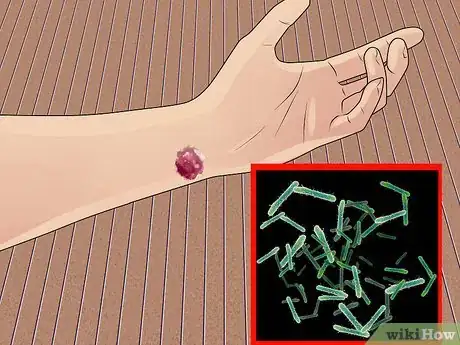
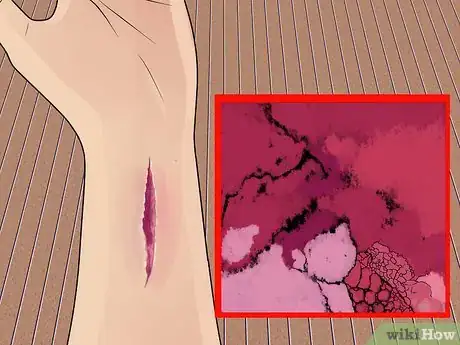
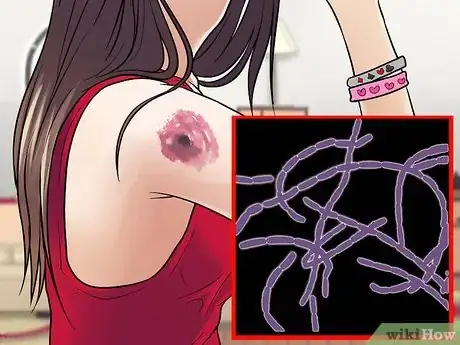



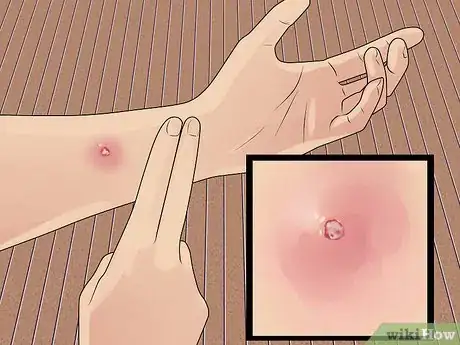
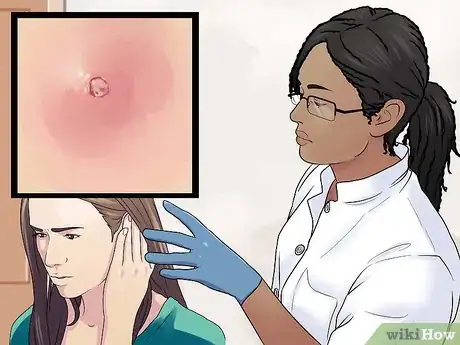
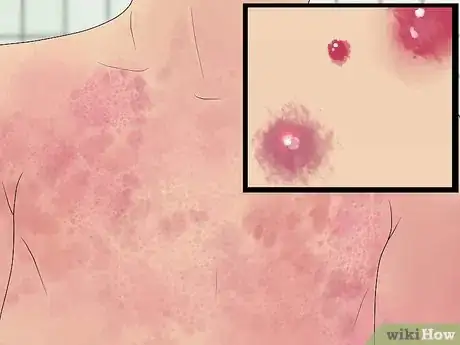
































































Medical Disclaimer
The content of this article is not intended to be a substitute for professional medical advice, examination, diagnosis, or treatment. You should always contact your doctor or other qualified healthcare professional before starting, changing, or stopping any kind of health treatment.
Read More...